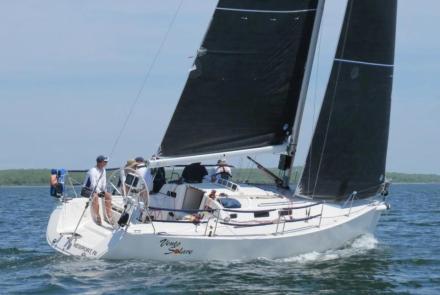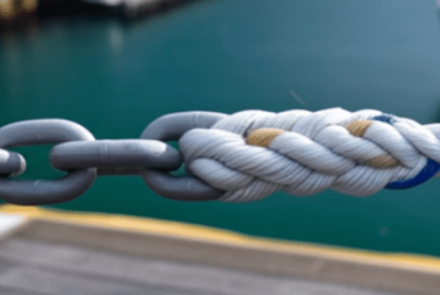The Infallible Memory of Navigational Devices: Forgotten workarounds can be a problem
“Safety Moments, presented at CCA Stations and Posts”
By Chuck Hawley, San Francisco Station, April 2021
Some of the following cautions are dated because modern electronics have improved over time and prevent us from making mistakes. User-interfaces generally get better by borrowing ideas from phones and tablets; displays are now typically touchscreens, making feature selection and typing easier; and graphics are easier to understand as you navigate along the coast.
It wasn’t always like this. In the early 1990s, when many promising but now absent brands were making their foray into marine GPS (Motorola, Magellan, Magnavox, Trimble), accommodations had to be made for the remarkable accuracy of these devices and their frequent disagreements with the Real World. Here are a few of the problems we used to have to deal with.
Chart Datums: Chart datums are complicated, but think of them as the assumptions about the Earth that affect the locations of charted objects. A datum takes into account the ellipticity and diameter(s) of the Earth, as well as the charted objects’ distance from the prime meridian. In the first decade of GPS receivers, it was the navigator’s responsibility to select a chart datum from a long list so that the displayed position on the GPS would correspond to the correct place on a chart. Charts in the US were generally made according to WGS84 (World Geodetic System, 1984 version), but maps from US Geodetic Survey were made according to the NAD27 (North American Datum, 1927) so differences existed even among the maps of the same country. Depending on the datum of the chart and what was entered into the GPS, positions could be plotted miles away from their correct spot, especially in island chains. But what was more vexing is that the previous selected datum would stay in the GPS memory as you traveled from place to place, causing unintended errors as you entered a charted area with a different datum.
Stan Honey has an interesting comment on datums, and this could also apply to the paragraph regarding Manual Lat-Long Corrections:
There is another chart problem other than the use of a non wgs84 datum. Some old charts are well surveyed, but are not located correctly with respect to ANY chart datum including the one listed on the chart. Mexican charts were the best example of this until just a year or so ago. The location of Puerto Vallarta was 1.5 miles off, and the rock SSW of Punta Mita had a significant error.
One easy work around is to download and then process Google Earth images to turn them into a raster nautical chart format, and then display them on Expedition or any chart plotter that can use RNCs. The coordinate accuracy of Google Earth is remarkable and in lots of areas that are worth visiting in boats, the color of the water makes it easy to interpret the extent of shoal areas. In my experience this approach worked really well in Mexico and Central America.
Manual Variation: Most GPS receivers had the ability to calculate magnetic variation using a model of the Earth’s isogonic lines. You’d see that variation was 12 degrees E in San Diego, and 22 degrees E in Seattle, and figure that everything else was calculated correctly as you navigated the coast. However, the calculated variation could also be a degree or two off, so the GPS allowed the navigator to override the calculated value and enter the known, precise variation and store it in memory. However, this information would stay in memory, despite the location of the vessel. As the vessel moved farther and farther away from the original location, the variation would get less and less accurate (unless the route of the vessel happened to follow isogonic lines…)
Manual Lat-Long Corrections: Nothing was quite as disheartening to an user of a new cartographic GPS as when the map would show their position 100 yards or more from their actual position in their slip. Errors could be far worse as well. GPS manufacturers “solved this” by either allowing the user to enter in a lat-long offset that would correct the position, or would allow them to put the cursor on their known position to apply a correction. However, this correction would remain in memory, altering the displayed position, as the vessel traveled to other ports, not necessarily improving the charted accuracy.
Magnetic or True: This issue is pretty obvious, but it still gets users in trouble. Navigational displays can be set to show courses, headings, and COG relative to magnetic north or true north. But many displays don’t give the navigator much feedback as to which is being used. Sometimes there is a small M or T shown, but it can be overlooked. Ideally, this would not be a closely held secret by the GPS, but would instead be shared freely with the navigator.
Feet or meters or fathoms: Cartographic displays can frequently be set to show charted depths in feet or meters (and to a lesser degree, fathoms). Unknowing users can get quite a start by seeing single digit depths and not realizing that the unit of measure is something other than feet. (CCA member Capt Mark Lenci, USN Ret, has a harrowing story about this issue in a nuclear attack submarine. The consequences would have been more than a bruised ego…)
So what’s the solution? Many of these issues have been rendered obsolete by better user-interfaces and smarter software. But it always seemed odd to me that manufacturers didn’t have a “welcome screen” that called out all of the potentially dangerous settings that were in the memory of the GPS. The screen would be a quick reminder that one’s memory is not as infallible as we would like to believe. Regardless, it would be prudent for all navigators on unfamiliar boats, or perhaps when returning after a period of time to a familiar boat, to ensure that the hidden, potentially helpful fudge factors buried in silicon memories are actually helping, not hurting, your navigational accuracy.
The Cruising Club of America is a collection of passionate, seriously accomplished, ocean sailors making adventurous use of the seas. All members have extensive offshore boat handling, seamanship, and command experience honed over many years. “School of Hard Rocks” stories, published by the CCA Safety and Seamanship Committee, are intended to advance seamanship and help skippers promote a Culture of Safety aboard their vessels





